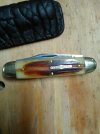Regarding a possiblility of the leather's tanning causing a problem, I'll just throw this in:
I have an old Western L48A fixed blade that was given to me by my father some 45+ years ago. I've gotten away, for the most part, with keeping the knife in it's leather sheath for that entire time. We've always lived in a very dry climate, in the southwestern U.S., so I haven't had any issues with rusting on the blade itself, even stored in it's leather sheath the whole time. The only issue I've had is, the brass guard kept showing some verdigris in a very specific, localized spot, where it contacted the leather. I'd periodically take the knife out and polish away the verdigris, then put it back into the sheath.
Just in the past few months, I finally tried something that I'd seen recommended online somewhere, to nip the verdigris issue in the bud once and for all. I removed the knife from the sheath, and put the sheath in a large Zip-Loc bag (1 gal. size)
with enough baking soda to completely cover and fill the sheath. I just set the bag aside for a month or more (I dated the bag with a Sharpie), and made a temporary blade cover from cardboard for the knife, in the meantime. After at least the month, or maybe nearly two, I pulled the sheath out of the baking soda and gave it a good rinse in the sink. The baking soda rinses away easily, both inside the sheath and out. I used a clothespin to hang the sheath on a clothes hanger in the closet, to dry out after the rinse. I left it there for a week or more, to ensure it was completely dry. Then, after all that, I finally put the knife in the sheath again. I pull it out of there every week or so, to look for any new staining or verdigris. It's gone and done; no problems with verdigris on the brass anymore, after 45+ years of 'tolerating' it.



